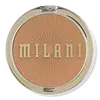What's inside
What's inside
 Key Ingredients
Key Ingredients

 Benefits
Benefits

 Concerns
Concerns

 Ingredients Side-by-side
Ingredients Side-by-side

Talc
AbrasiveSynthetic Fluorphlogopite
Mica
Cosmetic ColorantMagnesium Myristate
Octyldodecyl Stearoyl Stearate
EmollientDiisostearyl Malate
EmollientHydrogenated Polyisobutene
EmollientPhenoxyethanol
PreservativeCaprylyl Glycol
EmollientBenzyl Alcohol
PerfumingSilica
AbrasiveHexylene Glycol
EmulsifyingDehydroacetic Acid
PreservativeWater
Skin ConditioningAlumina
AbrasiveMagnesium Oxide
AbsorbentMaltodextrin
AbsorbentTin Oxide
AbrasiveIron Oxides
CI 77891
Cosmetic ColorantCI 77742
Cosmetic ColorantCI 75470
Cosmetic ColorantTalc, Synthetic Fluorphlogopite, Mica, Magnesium Myristate, Octyldodecyl Stearoyl Stearate, Diisostearyl Malate, Hydrogenated Polyisobutene, Phenoxyethanol, Caprylyl Glycol, Benzyl Alcohol, Silica, Hexylene Glycol, Dehydroacetic Acid, Water, Alumina, Magnesium Oxide, Maltodextrin, Tin Oxide, Iron Oxides, CI 77891, CI 77742, CI 75470
Talc
AbrasiveZea Mays Starch
AbsorbentZinc Stearate
Cosmetic ColorantDimethicone
EmollientMica
Cosmetic ColorantPentaerythrityl Tetraisostearate
EmollientOctyldodecyl Stearoyl Stearate
EmollientCaprylyl Glycol
EmollientSilica
AbrasiveHdi/Trimethylol Hexyllactone Crosspolymer
Nylon-12
Hexylene Glycol
EmulsifyingArgania Spinosa Kernel Oil
EmollientDiisostearyl Malate
EmollientLauroyl Lysine
Skin ConditioningCocos Nucifera Oil
MaskingGardenia Taitensis Flower
Skin ConditioningTocopherol
AntioxidantPhenoxyethanol
PreservativePotassium Sorbate
PreservativeAroma
CI 15850
Cosmetic ColorantCI 19140
Cosmetic ColorantIron Oxides
CI 77742
Cosmetic ColorantCI 77891
Cosmetic ColorantTalc, Zea Mays Starch, Zinc Stearate, Dimethicone, Mica, Pentaerythrityl Tetraisostearate, Octyldodecyl Stearoyl Stearate, Caprylyl Glycol, Silica, Hdi/Trimethylol Hexyllactone Crosspolymer, Nylon-12, Hexylene Glycol, Argania Spinosa Kernel Oil, Diisostearyl Malate, Lauroyl Lysine, Cocos Nucifera Oil, Gardenia Taitensis Flower, Tocopherol, Phenoxyethanol, Potassium Sorbate, Aroma, CI 15850, CI 19140, Iron Oxides, CI 77742, CI 77891
Ingredients Explained
These ingredients are found in both products.
Ingredients higher up in an ingredient list are typically present in a larger amount.
Caprylyl Glycol is a humectant and emollient, meaning it attracts and preserves moisture.
It is a common ingredient in many products, especially those designed to hydrate skin. The primary benefits are retaining moisture, skin softening, and promoting a healthy skin barrier.
Though Caprylyl Glycol is an alcohol derived from fatty acids, it is not the kind that can dry out skin.
This ingredient is also used as a preservative to extend the life of products. It has slight antimicrobial properties.
Learn more about Caprylyl GlycolThis ingredient is used to add a violet color to cosmetics.
It is created by reacting phosphoric acid, ammonium dihydrogen orthophosphate, and manganese dioxide.
Ci 77891 is a white pigment from Titanium dioxide. It is naturally found in minerals such as rutile and ilmenite.
It's main function is to add a white color to cosmetics. It can also be mixed with other colors to create different shades.
Ci 77891 is commonly found in sunscreens due to its ability to block UV rays.
Learn more about CI 77891Diisostearyl Malate is an emollient and most often used in lip products. It comes from isostearyl alcohol, a fatty acid, and malic acid, an AHA.
As an emollient, Diisostearyl Malate helps create a thin film on your skin to trap moisture in. This helps keep your skin soft and smooth.
Hexylene Glycol is a surfactant. Glycols are a class of alcohols. Hexylene Glycol is a surfactant and emulsifier.
As a surfactant, Hexylene Glycol helps gather dirt and oil on your skin to be washed away.
As an emulsifier, Hexylene Glycol helps keep water and oil together. This prevents them from separating in a product. Hexylene Glycol also thins out the texture of a product by lessening viscosity.
Hexylene Glycol has a small molecular weight.
Learn more about Hexylene GlycolMica is a naturally occurring mineral used to add shimmer and color in cosmetics. It can also help improve the texture of a product or give it an opaque, white/silver color.
Serecite is the name for very fine but ragged grains of mica.
This ingredient is often coated with metal oxides like titanium dioxide. Trace amounts of heavy metals may be found in mica, but these metals are not harmful in our personal products.
Mica has been used since prehistoric times throughout the world. Ancient Egyptian, Indian, Greek, Roman, Aztec, and Chinese civilizations have used mica.
Learn more about MicaOctyldodecyl Stearoyl Stearate is created from stearic acid.
It is an emollient and thickens the lipid (oil) portion of a product. Due to its emollient properties, it may not be fungal-acne safe.
Phenoxyethanol is a preservative that has germicide, antimicrobial, and aromatic properties. Studies show that phenoxyethanol can prevent microbial growth. By itself, it has a scent that is similar to that of a rose.
It's often used in formulations along with Caprylyl Glycol to preserve the shelf life of products.
Silica, also known as silicon dioxide, is a naturally occurring mineral. It is used as a fine, spherical, and porous powder in cosmetics.
Though it has exfoliant properties, the function of silica varies depending on the product.
The unique structure of silica enhances the spreadability and adds smoothness, making it a great texture enhancer.
It is also used as an active carrier, emulsifier, and mattifier due to its ability to absorb excess oil.
In some products, tiny microneedles called spicules are made from silica or hydrolyzed sponge. When you rub them in, they lightly polish away dead skin layers and enhance the penetration of active ingredients.
Learn more about SilicaTalc is a clay mineral. It helps absorb moisture and improve the texture of products. Like other types of clay, Talc can have a slight exfoliating effect on skin. Talc can be added to increase the volume of products.
Some Baby powders are made by combining talc with corn starch. The word "talc" comes from Latin and originates from Arabic. Talc is a mineral commonly found throughout the world.
If you have any concerns about using talc, we recommend checking out the FDA's official page.
Learn more about TalcThis ingredient is a combination of red, black, and yellow iron oxide pigments. This combination of colors is usually found in foundation, because it results in a "skin" color.